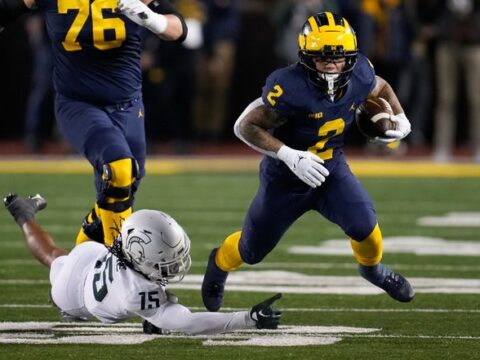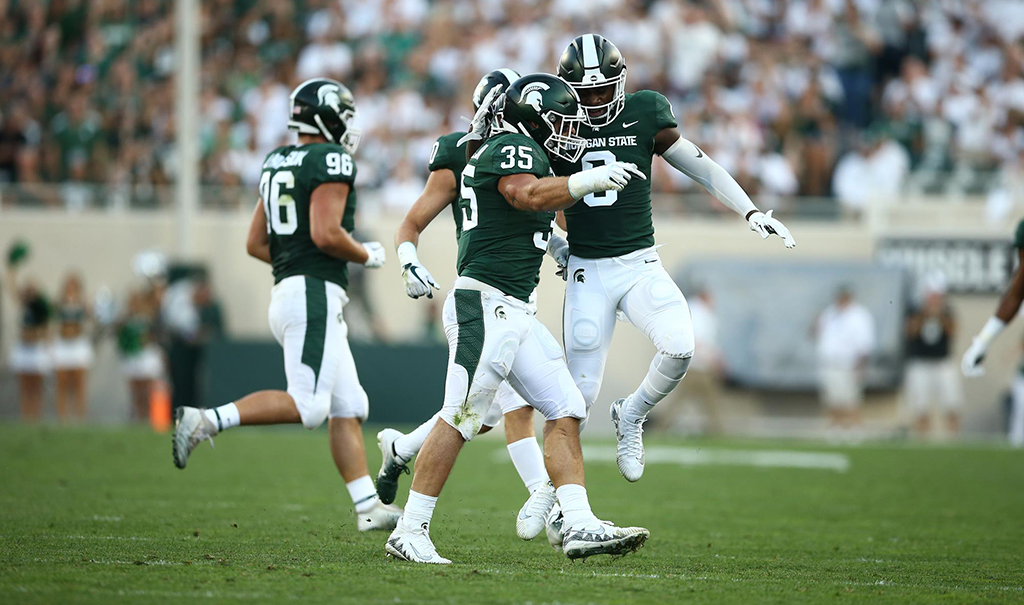
Without equivocation, Jay Johnson, Michigan State’s new Offensive Coordinator has a monumental task as it relates to resurrecting the Spartans Offense
You know part of the story: last season, the Spartans averaged just 372 Yards of Total Offense (#95 nationally), and averaged just 22 Points per game (#105 nationally & bottom 20th percentile of 130 D-1 Schools). By comparison, Ohio State claimed the Big Ten East and Big Ten Championship by averaging 530 Yards of Total Offense (#4 nationally), and averaged 47 Points per game (#3). That’s a difference of nearly 160 Yards and 25 Points per game.
But before, the Spartans can compete with Ohio State, they must climb over Indiana, Michigan and Penn State all of whom averaged more than 400 Yards and 30 Points per game and finished ahead of the Spartans in the Big Ten East.
So, into that mix comes Jay Johnson and it’s his job to correct course, but does he have the wherewithal?
The Jay Johnson profile:

Jay Johnson grew up in Minnesota, and earned a spot on the Quarterback depth chart at University of Northern Iowa from 1989 to 1992.
During his tenure, Northern Iowa won or shared three consecutive Gateway Conference Championships from 1990 to 1992 and compiled 31 wins offset by just 8 losses (Gateway Conference is now the Missouri Valley Football Conference).
As a highlight of Jay Johnson’s tenure, Northern Iowa earned 3 consecutive trips to the NCAA 1-AA Playoffs in 1990, 1991 and 1992 as well, and while they lost in the first round in 1990, then lost in the Quarterfinal in 1991, and lost in the Semi Final in 1992, it is a meaningful accomplishment to be in the NCAA I-AA Playoff for 3 consecutive seasons.
It’s uncertain if Jay Johnson contributed as a starter or backup at Northern Iowa, but it’s noteworthy that 2 time NFL MVP Kurt Warner was also on the Quarterback depth chart at Northern Iowa, overlapping slightly from 1990 to 1993.
After graduation from Northern Iowa, Jay Johnson immediately transitioned from playing to coaching, and took his first job in 1993 at Hickman HS in Columbia, Missouri.
After just one season at Hickman HS, Jay Johnson turned his attention to college, and coached college football for 25 years, from 1994 to 2019, and during that time he was Offensive Coordinator at 6 different schools, spanning 13 years, with significant intervals in between.
Immediately below is the list of schools where Jay Johnson was Offensive Coordinator:
- Augsburg University (D-III) 1994
- Truman State (D-II) 1995, 1996
- Southern Miss (FCS) ’05-‘07
- Louisiana (FCS) ’11-‘15
- Minnesota (FBS-Big Ten) 2016
- Colorado (FBS-PAC 12) 2019
Projecting Jay Johnsons impact as Offensive Coordinator at Michigan State:
Of course, as we try to project Jay Johnson’s impact as Offensive Coordinator at Michigan State, the other side of the story is that Jay Johnson has precious little experience as an Offensive Coordinator at Power 5 schools.
To ensure we are comparing “apples with apples” and “oranges with oranges”, I will start by making a couple assumptions: it’s not meaningful to analyze Offensive stats compiled by Jay Johnson more than two decades prior at D-II or D-III schools such as Truman State or Augsburg.
Another assumption is that it is not meaningful to try and analyze 2 years of stats posted at Southern Miss (an FCS school) more than a decade ago. Moreover, it is not meaningful to analyze stats posted at Louisiana (another FCS school) inasmuch as Louisiana was placed on NCAA probation and had to vacate 22 victories during Jay Johnson’s tenure from 2011 to 2014. In brief, the stats compiled at Louisiana from 2011 to 2014 are flawed and therefore irrelevant.
Yet, it is noteworthy that Louisiana was off probation in 2015 which was Jay Johnson’s final season at that school, and Louisiana posted a 4-8 record, averaged 380 Yards of Total Offense and 26 Points per game, yet it would be fair to say 2015 was not a banner season for Jay Johnson.
Thereafter, all we are left with are just two years of Offensive stats compiled by Jay Johnson at FBS (Power 5) schools and while it’s an extremely small sample…a “snapshot” if you will…nevertheless it’s the only relevant data available to measure Jay Johnson’s effectiveness as an Offensive Coordinator.
The two sets of data include one year at Minnesota (Big Ten) in 2016, and one year at Colorado (PAC 12) in 2019.
At Minnesota, Jay Johnson was Offensive Coordinator on Tracy Claey’s staff and the Gophers posted a 9-4 record overall/5-4 Big Ten and finished #7 Big Ten overall. At Colorado, Jay Jonson was Offensive Coordinator on Mel Tucker’s staff and the Buffaloes posted a 5-7 record overall/3-6 PAC 12 and finished #9 PAC 12 overall.
Immediately below are snapshots of Jay Johnson’s production as Offensive Coordinator at Minnesota and Colorado respectively:
2016: Minnesota averaged 357 Yards of Total Offense (#107 Nationally) including 174 Yards Passing (#111) and 29 Points per game (#63): Minnesota finished #7 Big Ten overall.
2019: Colorado averaged 389 Yards of Total Offense (#83 Nationally) and 238 Yards Passing (#61) and 24 Points per game (#100): Colorado finished #9 PAC 12 overall.
So what can we conclude from the preceding snapshot?
There simply isn’t enough Offensive data to draw meaningful conclusions regarding future success because in spite of 25 years of college coaching experience, there are only 2 years of stats posted by Jay Johnson as Offensive Coordinator at Power 5 schools and even at that, the two snapshots are taken for two individual seasons, at 2 different schools, in 2 different conferences and 3 years apart.
And when we average Jay Johnson’s stats at Power 5 schools including Minnesota 2016, and Colorado 2019, his combined average was just 373 Yards and 27 Points, and that’s essentially the same as the Spartans average of 384 Yards and 23 Points posted during the same two seasons, and that includes the Spartans dreaded 3-9 campaign in 2016.
So, as we try and predict Jay Johnson’s future success based upon the stats available it would be tantamount to “flipping a coin”. Further to that point, at 50 years old and 25 years into his college coaching career, we’re uncertain “just why” Jay Johnson only has 2 years of experience as an Offensive Coordinator at Power 5 schools, yet it is, what it is.
So, that brings us to the Power 5 Championship landscape.
Colorado offensive coordinator Jay Johnson during Colorado football practice and fall sports media day.
The 500 Yard/40 Point Club…
 If a team hopes to consistently compete for Division Championships, Conference Championships and consistently get invited to the College Football Playoffs, then “ball control” football is simply not enough anymore.
If a team hopes to consistently compete for Division Championships, Conference Championships and consistently get invited to the College Football Playoffs, then “ball control” football is simply not enough anymore.
Ball control football could best be described as: “control the football…control the clock…move the chains…mitigate mistakes…dominate with Defense…and score ‘just enough’ points to win”: but ball control football has gone the way of the horse & buggy.
When we think of “ball control football” we think of Jim Tressel, otherwise known as “Tressel ball”, yet the evolution at Ohio State from Jim Tressel, to Urban Meyer and then Ryan Day demonstrates how the evolution of Offensive Football has rendered “ball control football” obsolete.
Jim Tressel won 106 games at Ohio State from 2001 thru 2010 (NCAA violation aside) offset by just 22 losses. Jim Tressel was the poster child for “ball control football”. Of course, Tressel won a National Title in 2002 with an unblemished 14-0 record and in so doing, averaged 365 Yards of Total Offense and 29 Points per game. Of course, Mark Dantonio was Defensive Coordinator on that team while Jim Bollman was Offensive Coordinator and both were disciples of Jim Tressel’s philosophy.
Immediately below are Jim Tressel’s stats during his 2002 Championship season, compared to Urban Meyer’s 2014 Championship season, followed by a comparison to Ryan Day’s first season at Ohio State whereby he reached the College Football Playoffs in 2019.
- Tressel (2002): 365 Yards & 29 Points per game
- Meyer (2014): 512 Yards & 45 Points per game
- Day (2019): 530 Yards & 47 Points per game
In summary, Ryan Day averaged 164 Yards & 18 Points more per game than Jim Tressel’s Championship season, and yet Ryan Day came up short in the race for the National Championship.
To further demonstrate the evolution of Offensive production, if we measured Jim Tressel by 2019 standards, his Offense would rank #100 (when measured against 130 D-1 Schools), and #64 Scoring. Against Big Ten competition, Jim Tressel’s Offense would rank #11 out of 14 in 2019, and scoring would rank middle of the pack at #7.
Now let’s look at the Power 5 Champions in 2019…
Immediately below is a list of the teams that won the SEC, Big 12, Big Ten and ACC in 2019, and they are also the teams that competed in the College Football Playoffs last season and all are members of the “500 Yard/40 Point Club”:
- LSU: 569 Yards & 48 Points per game
- Oklahoma: 538 Yards & 42 Points per game
- Ohio State: 530 Yards & 47 Points per game
- Clemson: 529 Yards & 44 Points per game
So, it is abundantly clear that the Offensive baseline to compete for the National Championship has eclipsed 500 Yards and 40 Points per game and “ball control football” is no longer in fashion.
Further to that point, there were 10 teams in the “500 Yard Club” last season, including Alabama which compiled a record of 11-2, averaged 511 Yards and 47 Points per game…yet failed to win the SEC.
For the record, Alabama lost to LSU 41-46 last season, and while Alabama compiled an impressive 541 Yards and 41 Points in that game, on the other hand LSU posted 559 Yards and 46 Points and claimed a 5 point victory. Ten years ago that game would be referred to as a “shootout”, yet in 2019, it was just another afternoon amongst Top 10 teams.
To bring the “500 Yard/40 Point Club” into focus from Michigan State and Jay Johnson perspective, last season Michigan State averaged just 372 Yards & 22 Points per game, while Colorado, guided by Jay Johnson averaged just 389 Yards & 24 Points. In either case, both Michigan State and Colorado were woefully short of the 500 Yard/40 Point threshold.
I point this out because the “500 Yard/40 Point Club” is what Jay Johnson must aspire to, and yet 500 Yards guarantees nothing, it simply gets a team into the championship conversation: Just ask Alabama!
At the bottom line:
The challenge is clear and the implications are clear: if Jay Johnson and the Spartans hope to consistently compete for Division Titles, Conference Titles and earn invitations to the College Football Playoff in the third decade of the 21st Century, then they must arrive at a place whereby they are consistently listed in the “500 Yard/40 Point Club”, but that will be a tall order.
After all, the Spartans haven’t averaged 500 Yards and 40 Points per game since 2014, but perhaps more problematically is the fact Jay Johnson has never eclipsed 400 Yards and 30 Points per game as a Power 5 Offensive Coordinator. That doesn’t mean Jay Johnson can’t get to the 500 Yard/40 Point threshold but history tells us that he has a steep hill to climb.
Let’s remember, Jay Johnson and Mel Tucker said publicly they want to deploy “Ball Control” Offense, but let’s hope they revise their thinking and adopt a more high octane philosophy. I think I have pointed out that “Ball Control” football as we know it, or what some would refer to as “Tressel Ball” is insufficient in 2020.
If a team is unable to roll up 500 Yards and score 40 points or more per game they simply won’t be in the Championship conversation.
So let’s hope Jay Johnson at 50 years old comes of age as an Offensive Coordinator and joins the “500 Yard/40 Point Club”. After all Jay Jonson will be paid $975,000 per year, that’s an increase of $425,000 compared to his compensation at Colorado, so Jay Johnson is being compensated as a Championship caliber Offensive Coordinator, let’s hope he produces the Yards and the Points.
We’ll look at Scottie Hazelton, the Spartans new Defensive Coordinator in my next Blog.






